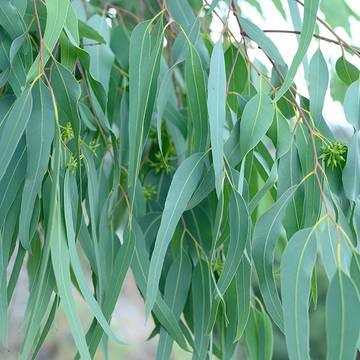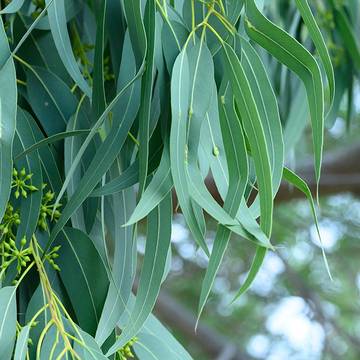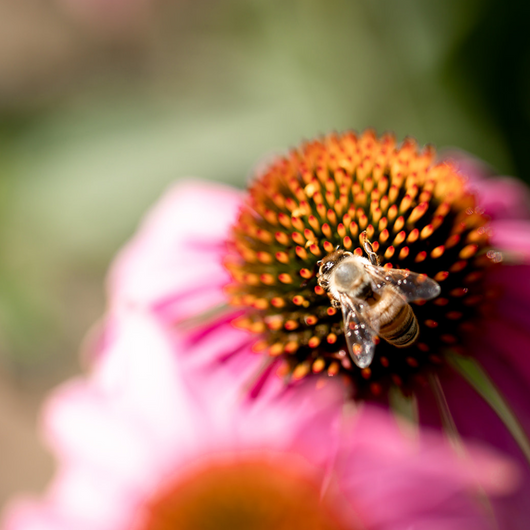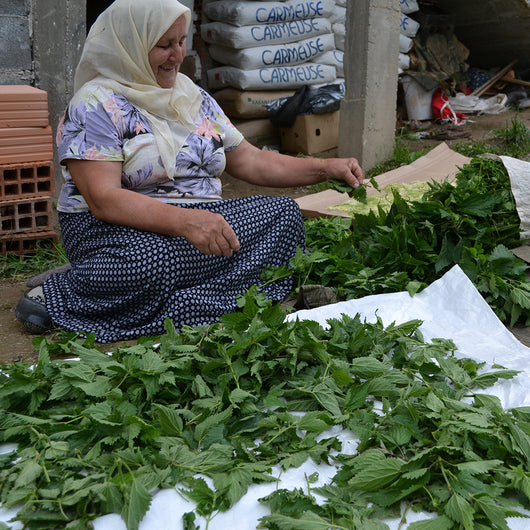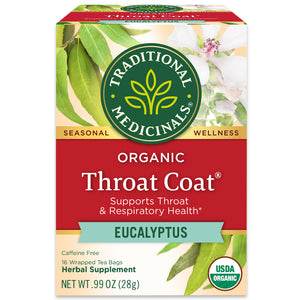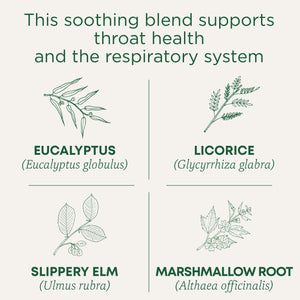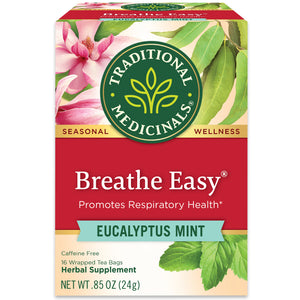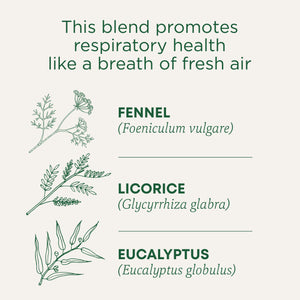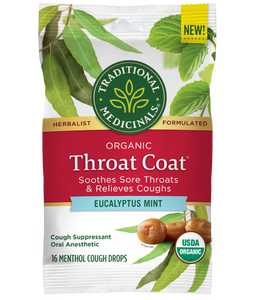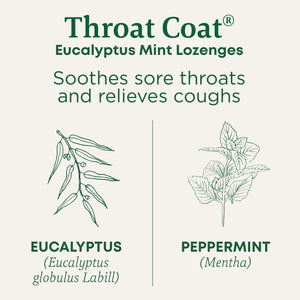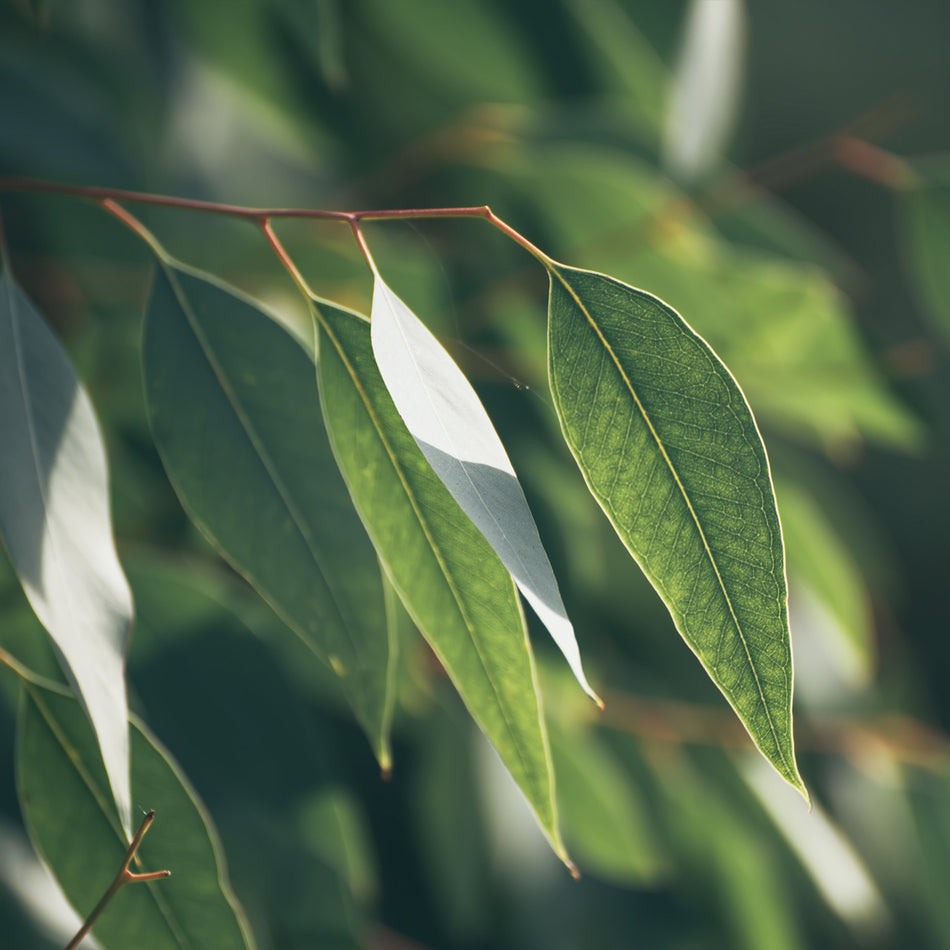
Eucalyptus
Eucalyptus globulusEucalyptus leaves have been used to breathe in benefits supporting the respiratory tract for generations.*
Eucalyptus, a recognizable fragrance with big benefits.
What are the Benefits of Eucalyptus?
The essential oil-rich leaves of eucalyptus are used in steams, syrups and lozenges to support the respiratory system, as an essential oil for cleaning, and in teas for respiratory support like our Throat Coat® Eucalyptus and Breathe Easy® blends. Specifically, its primary essential oil, eucalyptol (1,8-cineole), which is present in other aromatic herbs like peppermint, rosemary, and sage, is ideal for supporting chest and throat health.*
Eucalyptus leaves have an incredibly refreshing mint-like taste, which provides an invigorating touch of comfort when you need it most. It’s a great ally for winter or times of occasional stuffiness. In fact, many herb lovers like to bring the leaves inside and hang them in moist environments like bathrooms and showers to experience its aroma more frequently. Because of its powerful medicinal profile and incredible growing power, it’s no wonder this plant is a cherished traditional plant medicine that has made its mark worldwide.*
Folklore & Historical Use of Eucalyptus
Botanists have long been fascinated by this fast-growing gum tree, which excretes a sticky antibacterial resin to deter pests. Starting in the late 1700s, people began to propagate eucalyptus abroad with hopes to mitigate the challenges of their rugged ecosystems – such as reducing moisture in mosquito-prone habitats, rebuilding forests after rampant deforestation, or providing cover for areas that needed giant wind breaks. Some were just plant lovers who wanted to propagate the tree solely for its novelty. Others saw the plant as a get-rich scheme, and in the late 1800s, one developer planted over eight million eucalyptus trees on a fourteen-mile strip from Berkeley to Oakland, California. Spoiler alert, it wasn’t a good idea, nor was it profitable.
It turns out that the ubiquitous California eucalyptus has proven to be more harmful than helpful. The plant loves water, and at the same time, is fuel for fire. But, its resilience and abundance are true testaments to this plant’s power, and it provides so many different resources. The wood from eucalyptus can be used for timber, fuel, or even—didgeridoos! The bud caps make rather cute buttons, and the leaves are prized by herbalists for herbal medicine making.
Botanical Description & Habitat
There are over eight hundred species of eucalyptus, ranging from tall flowering trees to smaller shrubs. They’re all indigenous to Tasmania and Australia, but like other medicinal plants, eucalyptus can grow (and thrive) on almost every continent.
You may have noticed it before, the tree has a unique peeling bark and brightly colored fuzzy flowers—or more technically, stamens. While there are many shapes and sizes to eucalyptus leaves, this medicinal species has long, narrow leaves that are very aromatic. It tends to grow in hot to temperate climates, but doesn’t do well in freezing temperatures. The leaves are famously eaten by koala bears, in its native habitat of Australia.
When To Use Eucalyptus
Pair with echinacea when your system needs a boost.
Breathe deeply and sip slowly when in need.
Keep stocked in your cold weather apothecary for surprise moments.
Combine with soothing herbs like slippery elm and marshmallow.
The Business of Sustainable Plants
Our business is rooted in plants, and for us, it’s a business imperative that we care for the ecosystems where these plants live and thrive. We believe that everything is interconnected, which means supporting ecosystems and the farmers and collectors who harvest and gather our herbs. Finding opportunities to reduce or eliminate emissions at the source, we support organic and regenerative farming practices as well as voluntary certifications like Organic and FairWild. These ensure the absence of pesticides, herbicides, as well as the ongoing sustainability of wild collection, and the health and livelihoods of the collectors who forage. Josef Brinckmann, Traditional Medicinals’ Research Fellow, Medicinal Plants and Botanical Supply, asserts, “Everyone has a role to play in preserving biological diversity. One way of doing that is by equitably supporting the local people to serve as stewards of the land.”
It Starts with Organic
We choose to source organic because we believe in the positive impacts it has on environmental sustainability, biodiversity, and overall ecosystem health. Organic helps us increase transparency while prioritizing consumer well-being and farmer success, which is key to producing the high-quality herbs we source. In 2021, we procured 2.73 million pounds of certified organic herbs, over 99.7% of our total botanical herbs purchased. Volumes were down slightly from FY20 due to timing of inventories received.
The impact from organic farming creates a vital ecosystem through improved soil health, water quality, pollinator habitats, and biodiversity. Organic farms also have increased carbon sequestration potential through long-term carbon storage in the soil, helping to mitigate climate change.
One of the benefits of organic that we most value is farmer health. We care deeply about the people who produce our herbs, ensuring that they are not exposed to synthetic chemicals found in conventional agriculture.
Fair Trade
We believe that everyone deserves a fair wage for hard work. That’s one of the reasons why we’re committed to fair trade. Traditional Medicinals® is a registered Fair Trade “brand holder”, “licensee” and “manufacturer,” and our products are certified by Fair Trade USA, an independent third-party certifier. We were an early adopter of Fair Trade, having launched our first fair trade tea product in 1998, just one year after Fairtrade International (FLO) was established. We continue to work closely with our network of producers to help them to implement fair trade standards and get certified.
Throat Coat® Eucalyptus Tea
Throat Coat® Eucalyptus Mint Lozenges
Additional Information
Legal Disclaimer:
The information and other content in this article is designed to provide a general overview of the botany, cultural history, and traditional uses of this herb. It is not intended and should not be construed as health advice. Every person is unique and you should consult with your health care provider before using any herbal product or supplement.

